Carpeted coatings for home. Firms representing their products in the Russian market. The technique of making coatings, pile characteristics, painting. Laying methods, care tips and other practical recommendations.
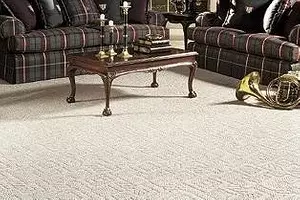
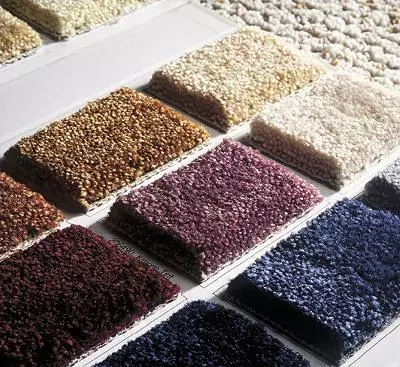
All positive qualities of the carpet in his "descendant" are saved. It is impossible to slip on the darous surface, the load on the spine and joints is reduced, the human gait is made easier and elastic. The coating is more complex on the structure of the framework, which allows you to significantly diversify the shape and methods of fixing the pile.
The base consists of two layers glued with latex (they are usually called primary and secondary bases). The primary is made of dense synthetic fabric (caprolactam), into which the fibers of the pile are woven. Next is applied by sticky latex, after which they press the secondary base, which closes the places of fastening of the pile and the generator of the carpet coating. Punching of the secondary basis can be used foam or rubberized latex, felt or some elastic synthetics, but the jute, natural or artificial is used most often. Artificial jute is usually preferred because of its water resistance: it does not swell, does not rot, it is not deformed and does not give a shrinkage. The two-layer coating base, in contrast to the single-layer carpet, increases such important characteristics of the pile, as elasticity, sound and thermal insulation, wear resistance, shrinkage resistance and sliding.
Many diverse coatings offer our consumers from the following countries: Belgium (Lano, AW, Associated Weavers, Desso, Bic, Tasibel and Creatuft), Denmark (EGE), France (Berry Tuft and Tarkett Sommer), United States (Beaulieu of America and Shaw Industries ), United Kingdom (Brintons and Bonar Floors), Canada (Peerless), Germany (DURA). Among domestic producers, such companies as "Lyuberetsk carpets", "Obukhovsky carpets", "Koroteks" can be noted.
By the method of production, the carpet can be woven, tuffing, needle-free or flocked.
Woven carpet products learned to make in deep antiquity. In this case, the pile is formed by interlacing one-photographic or multi-colored yarn and tie nodes to a particularly durable basis. The ends of the pile nodes are endured on the front and cut evenly. Weaving carpets (WILTON, AXMINSTER - for a two-fluid production method) allow you to mix woolen and synthetic yarn of all kinds of colors with a width of the canvas to 4.5m. According to production technology, woven carpets are closest.
With a tuffing method, a needle with a thread pierces the basis and leaves a predetermined height with the front side. Next, they can be cut directly on the machine to form a pile, after which the interlacing from the inside the base is fixed by latex. The productivity of such machines is an order of magnitude higher than when a woven method, and the width of the canvas can be 4, 5 and even 6m (weatshirt produced by the United States and Canada - 3.66m). In this way, about 75% of all carpets are manufactured.
The needle-free method implies multiple piercing of the fibrous basics needles with special zabbins (order 3GL by 1mm2). The jar is captured by separate fibers. The firmware is not needed, since the fibers are confused quite bizarre and tightly and without it. This product is rather similar to the felt than on the pile, but cheaper and easier to care. The needle and tuffing methods include gluing from the outline of the secondary base layer.
With a flocking method, a pile is formed from millions of thin porcers with a length of 3mm, built strictly vertically with an application of an electrostatic field and protruding from a porous polychlorvinyl base. The pile density is the highest (about 80Vorsok for 1mm2). The width of the needle-free and flocked coatings usually does not exceed 2m.
Characteristics of carpet pileVault largely determines the appearance of the carpet. But it also affects the comfort, convenience of cleaning, durability, noise absorbing and other properties of the product. That is why the selection of a pile, or rather, the three main characteristics of the form, sizes and material is to pay special attention.
Vors shape . The pile of tuffing coating can consist of either loops or from the villion. Moreover, the latter are obtained by cutting (CUT LOOP) or cut (sheared loop) tops first. That is why they say: the pile of looting or a staring (cut). IT and the other is homogeneous or heterogeneous in height, may consist of direct or twisted threads, as well as their combinations. There are a lot of combinations, but, according to the testimony of Manufacturers of Brodlum Center LLC and networks of specialized CARPET HOESS stores, the first pile is most often used (the pile of looting; Stripped straight and cutting twisted; looped-cut straight and looped stewed. Pile height It can be both single-level and multi-level).
Density, weight and height of pile . The more often the fibers are, the higher the pile density. At the same time, a more dense pile preserves the original appearance, the shape, elasticity, is less abruptly, and the dirt penetrates worse. The density is estimated by the distance between the fibers both in the width (in the "geyjah") and the length (sediment) of the coating. But these values even in one product are not necessarily the same. Easier the concept of "silent mass". It is measured in g / m2 in Europe and in ounces / yard2 in America, Canada and England. More often it happens from 680 to 2584 / m2, but you can find coatings with a density of 544 to 3820 / m2 (if the density in ounces / yard2 is known, then it is necessary to multiply the existing value to 34).
In the height of the pile conventionally distinguish between the short-sighted (the height of the Village is up to5mm), stretched (5-15 mm) and high-voltage coatings (from15 to 40 mm and above). Knowing the mass and height of the pile in metric units, it is easy to calculate its density of the first to the second and multiplication of the private to the number27. But the choice of coating by weight of the pile is ambiguous: a high pile of a small density can have the same mass as low high density. Selief seller you can choose the optimal ratio between the density and height of the pile.
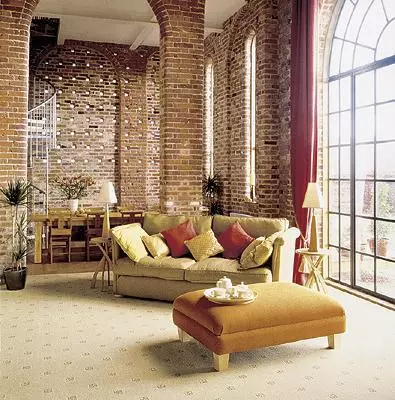
Woven coating from the National Trust collection (Brintons). Material: wool - 80%, polyamide- 20%. Material Vors. It may be natural, artificial or synthetic and used in the production of coatings both in the form of separate fibers and in the form of yarn of them. There are fiber and puddle yarn. The first is obtained by weave long (up to 10km) parallel synthetic fibers, twisting short (from 12 to 220mm) the fibers of any type. With flocking method, 3-mm fibers are used.
Natural fibers are vegetable (cellulose) or animal (protein) origin. Plant include flax, cotton, jute, paper, sisal, coconut; Kezhivoy wool and silk. According to Carpet House managers, wool can absorb moisture up to 30% of their weight and stay dry to the touch. This is an order of magnitude greater than in the case of synthetic fibers. The woolen carpet is very elegant, but accumulates the electrostatic charge and exposed to moths and mold. It is characterized by reduced flammability and is rather smoldering and disappeared than burning. The quality of the coating depends on the way of spinning, the type of wool and the type of special processing. Let's say wool carpets of BRINTONS and CREATUFT CO quality sign Fernmark Quality made from crossbred wool specially derived New Zealand sheep "carpeting" rocks.
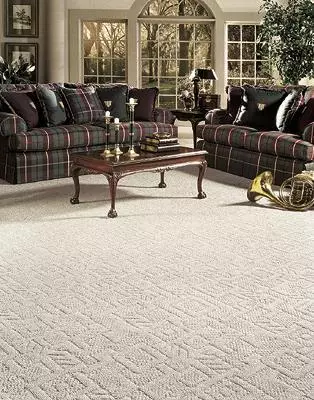
Tafting coating SHOOTING (Beaulieu of America) with a looped multi-level pile. The covered coatings of such vegetable fibers, like sisal and coconut, appeared relatively recently. At least in Russia. Dried in the sun and woven leaves of a sisal-grassy subtropical shrub of a family of agave- do not accumulate an electric charge, but a bit rigid. The coating of them differs pleasant to the eye with light brown "woody" color. Application of the application on one side of natural latex acquires high wear resistance. Material from coconut is even more cozor and wearless. Pretty original coverage of paper (!). It is characterized by good consumer properties. Coatings of the three species abovems are usually made without any synthetics: Ilatx, and only natural jute are used in them.
Artificial fibers are most often produced from viscose and acetate, but in floor coatings are used quite rarely. But synthetic fibers made of polypropylene, polyamide, polyacryl and polyester in modern carpets are extremely wide. To improve air permeability and strength, they are corrugated and twisted.
Polyamide (nylon, kapron) is the highest quality material. But the coating of it is 3 times of polypropylene and only in 2 times cheaper woolen. Fiber flexible, porous and many things. The yarn can be painted in a wide variety of colors and shades. At the same time, the material has the property of accumulating the electrostatic charge, therefore, its antistatic properties have to be improved during the manufacture of fibers. Polyamide is less resistant to acids than polypropylene, and absorbs more moisture.
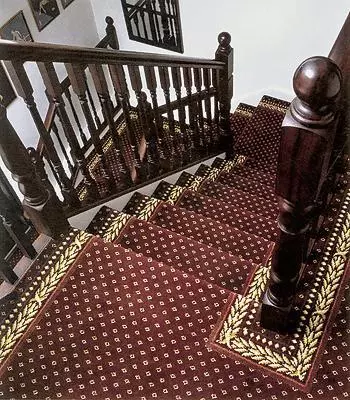
Pretty effectively when carpet on the inner staircase and in the premises adjacent to it represent a single ensemble. The most famous manufacturers of such fiber - du Pont, BASF, NOVALIS, SOLUTIA. For example, in the modification of the Antron Excelsc fiber from polyamide6.6, DuPont has implemented a number of scientific and engineering ideas. Now it can have a rectangular cross section with rounded corners and four holes passing along the entire fiber. It increases the scattering of light rays falling on it and makes the contamination of the coating is less noticeable. Introduction of modified coal to ensure antistatic properties, antibacterial and antifungal treatment, as well as an increase in wear resistance (by 20% compared to conventional polyamide) turned this material into one of the most popular for carpet coatings. Fine cases, its dirt-repellent properties are improved by applying a thin layer of Teflon (American firm 3M uses its version of such a protection of ScotchGard).
The coating from any synthetic material can be cleaned with a detergent vacuum cleaner. According to the specialists of Bobrov Company, the official dealer of the Tarkett Sommer concern, the waterproof needle coating Aquadry completely dries after 8 hours after such a cleaning. Additional antibacterial treatment will eliminate the appearance of moths and the deposition of larvae ticks in the pile. But at the avid smokers, the synthetic is able to deliver a lot of chagrins, because by chance of a fallen ash or cigarette can melting a rather noticeable stain spot on the surface. Another thing is a woolen pile: cleaned the walled tips of the veil - hooping as a new one.
Woven, wicker, needle-free and flocked carpets| Manufacturer | Name | View | Material | Width, M. | Price 1 m2, $ |
|---|---|---|---|---|---|
| Brintons (Great Britain) | Marquis. | Fabric | Wool (80%), polyamide (20%) | four | 80. |
| Abbotsford. | Fabric | Wool (80%), polyamide (20%) | 2. | 145. | |
| Tasibel. (Belgium) | Tasitweed. | Wicker | Coconut fiber | four | from 66. |
| Tasitweed. | Wicker | Sizalo fiber | four | from 44. | |
| Niagara. | Wicker | Paper fiber | 3,66. | from 86. | |
| Tarkett Sommer. (France) | Aquadry. | Needralobivoous | Polyamide | 2. | from 15. |
| Tapison 600. | Needralobivoous | Polyamide | 2. | from 7.3. | |
| Bonar Floors (United Kingdom) | Flotex 150. | Flokned | Polyamide | 1.5 | 40. |
| Flotex 200. | Flokned | Polyamide | 2. | fifty |
| Manufacturer | Name | Width, M. | Pile | Price 1m2, $ | |||
|---|---|---|---|---|---|---|---|
| The form | Material | Mass, g / m2 | Height, mm. | ||||
| Creatuft (Belgium) | Malta. | four; five | Peel, single-level | Wool | 1900. | eleven | from 54. |
| Ceres. | four | Styled, twisted, single-level | Wool | 1400. | nine | from 56. | |
| Aw (Belgium) | Cheviot. | four | Looping, multi-level | Wool | 1700. | 6. | from 34. |
| New Atlantic Gold. | four; five | Looped-cut, straight, multi-level | Polyamide | 1450. | nineteen | from 26. | |
| Oregon. | four; five | Looped-cut, twisted, multi-level | Polyamide Antron. | 920. | nine | from 26. | |
| BERRY TUFT. (France) | Rossini. | four | Strained, straight, single-level | Polyamide | 480. | 3.5 | from 18. |
| Phnoenix. | four | Looped, straight, straight, single-level | Polyamide | 1100. | 12 | from 23. | |
| BIC (Belgium) | New Sensation. | four | Styled, twisted, multi-level | Wool | 1700. | 10 | from 225. |
| Apila. | four | Looped-cut, twisted, single-level | Wool | 2300. | 10 | from 249. | |
| LANO. (Belgium) | Lano-Coulibri. | four; five | Strong, straight, multi-level | Polyamide | 700. | 3.5 | from 28. |
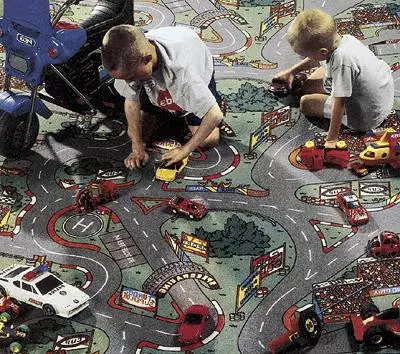
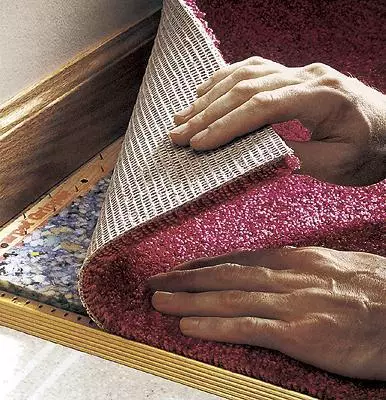
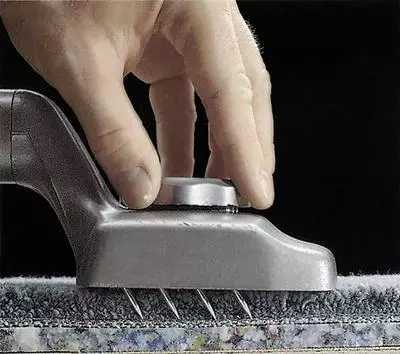
Broadloom type coverage with a substrate and a kicker for its tension on a fruit rack. Coloring can be made at different stages of carpet manufacture. The volume color of the synthetic polymer (Vmassa) is carried out even before pulling the fibers from it. At the same time, the color scheme is very limited. The yarn is immersed in a container with coloring matter, a variety of possible shades is the greatest. Ivperv and in the second case, the number of colors of the carpet coating is determined by the number of yarn threads that allows the machine to use (as a rule, to 60). The drawing is obtained regular, that is, repeated in certain periods of length. Finally, the paint can be applied to the finished carpet coating through the stencil (drum or flat, usually with the number of colors 8-12) or the injection of the pipse through the nozzles with narrow holes. This is done according to a predetermined program implemented by microprocessor.
According to BrandISchnipper managers, a flat stencil and inkjet printing allow you to create the most intricate pattern, the scene, asymmetric and even proposed by the customer. For inkjet printing, the drawing can be recorded on a diskette or CD. Such "coloring" brings the carpet, manufactured by a machine method to exclusive handicraft. When printing on a stencil, the resistance of the color to abrasion is worse than when painting the yarn dip. But in the case of inkjet printing, according to Milliken equipment manufacturers, Milliken and Austrian Zimmer, ensures the same deep penetration of the dye into the material, as well as during immersion. Dark and very light coatings look more spectacular by the neutral tone, but the dirt on them is much more noticeable. Figure in the form of an ornament, especially motley, well hides pollution.
Methods of carpet flooringOn the form of release distinguish roll and lump coverage. The first is more convenient, but less exclusively.
The material is fill in two main ways: directly to the floor or on an intermediate substrate. At the first pile, in the future weathered much faster, because he is constantly experiencing an increased abreast effect while being between rigid floors and our shoes. This method is quite suitable if it is assumed periodically, every 3-4 years, to change the coating. In the second case, the service life of material is over 10 years. Moreover, you can create the effect of drowning legs in a thick soft pile, even with a thin and rather inexpensive carpet of the coating. The effect of a long soft pile will create an elastic substrate with a thickness of 6-15 mm. At the first method, the coating is fixed on the plane with the help of adhesive composition or bilateral tape. Ito and the other can be applied both on the entire area of the floor and in the form of a grid of individual intersecting strips. The method of laying the coating directly to the floor is effective for the premises of a large area (more than 50m2).
In the second method, the coating is either glued, or just a steering on the substrate previously glued to the floor. It is most often made of porous rubber. The reasons for this are at least three: first, the rubber has very good elasticity; Secondly, it does not rot in the humid environment and long retains its properties; But the main and allowing characteristics exceeds all materials used in the construction.
According to experts from "Kontraftstroy", the high base of the foamed PCV, which is equipped with a flocked coating, will save your tools, because it is not necessary to buy a substrate.
If the glue is not used, the fastening of the material to the floor is carried out mechanically, with the help of a gripper-wooden rail, from which nails stick up at a certain angle. It is pre-fixed on the floor around the perimeter of the room. The edge of the carpet is put on a flu, using a special "paw" with a pins. That is exactly what Broadloom coatings are filaded (connected are connected). Practical Americans and Canadians laid a substrate directly on a thoroughly aligned concrete tie or boarded floor, which allows them to periodically change the carpet cover without any hassle.
Very carefully need to take a link of the junction of the canvase. Who will like it, if after a short time its edges will suffer and dirt and dust are added under them? Usually try so that the joke is in the least involved area of the room. To connect edges, a sticky or thermal adhesive tape is most often used. By perimeter, the coating presses the plinth, which can be wooden, plastic or from the same material as the coating itself.
Several practical recommendations
- In the living room, it is better to be a tapping carpet with a single or multi-level looping or short-cut pile. On the kitchen product with a single-level looped pile or needle-passible, but in any case, split pattern. Starting will be pleasantly step along a high cutting pile, one or multi-level. The caves more often placed coating with a single-level cut or looped pile, while many give preference to wool. The wedn room may turn out to be an indispensable flocked coating. Finally, a needle-free product with water-repellent impregnation is quite practical to the hallway. Avot in the office or on the loggia it is quite possible to use a wicker coating from an exotic material.
- If you are afraid of leaks, stop your coating with a pile and the basis of a synthetic fiber that is not deformed in a humid environment. At the same time ask if the adhesive compositions used in the formation and flooring of the material have water-repellent properties.
- When calculating the required number of square meters of coating, do not forget to add to the add.5% on the cutting, so that then it does not have to pull too hard or buy a "strip".
- To accurately select the tone of the carpet, capture a piece of wallpaper to the store, in order to more accurately appreciate the possible color combinations. It is best to check the selected colors in both natural and artificial lighting.
- With the flooring of the coating of several cavities, be sure to take them from one roll or at least from one batch. Otherwise, a certain inset of color cannot be excluded, which can be noticeable immediately or manifests itself with time.
- At least once invited to carry out dry chemical cleaning of carpeting of professionals. This will help you to evaluate your own opportunities in the development of this rather difficult procedure.
Specialists of the Concern Du Pont believe that for a long preservation of an attractive appearance of carpet coverage, it is enough "just" to spend three well-known procedures with it in a timely manner: to regularly clean the vacuum cleaner (at least once a week), periodically subjected to dry chemical cleaning (about once every six months ) and promptly remove stains (it is best to immediately after the occurrence). The "first-aid kit" to restore "Health" of the carpet should contain six attributes: 1) Washing agent, 2) Solution of ammonic alcohol, 3) 50% acetic acid solution, 4) Stainover for dry cleaning, 5) Water absorbent paper Towel, 6) Wet napkin. The variants of their consistent use at the most frequently arising in the road spots on the carpet of the coating are shown in the table.
When removing the stains, the French company Tarkett Sommer recommends complying with seven basic rules: act quickly; remove the maximum amount of dirt mechanically; use special chemicals and only white napkins; heave the towel with a chemical, and not pour it on a stain; Apply the drug by non-rubbing, but with rigging movements - dial from the periphery to the center.
But even the most careful attitude towards carpet coating still forces it to periodically change it. Thus, the annual "consumption of" consumption of carpeting per capita in Europe is 2-4 m2 (Wangly 5m2), and from us - 0.1 m2.
Methods for cleaning household spots on carpet| The origin of the spots | Cleaning method |
|---|---|
| Gutalin, Cosmetic Cream, Hair Nail Polish, Oil, Sale, Mascara | 4-5-1-5-6 |
| White Glue, Toothpaste, Ketchup, Mayonnaise, Ice Cream, Milk, Cheese, Chocolate, Egg | 1-5-2-5-1-5-6 |
| Wine, cocktail, beer, lemonade, sweets, berries, juice, tea, coffee | 1-5-3-1-5-6 |
| Wax, chewing gum | * -6-5 |
| Shoe Cream, Paint, Food Dye, Rust, Curry Sauce | ** |
* - freeze ice cubes - crush - remove with a vacuum cleaner
** - contact the professional cleaning of carpet products.
The editors thanks the chain of CARPET House stores, the company "Brodlum-Center", Brandischnipper, LLC "Kontraktstroy", "Bobrov Company", representative offices of Beaulieu of America, DuPont, BTM Textilemaschinen, Concern Tarkett Sommer, as well as the director of the technological center of TSNIIURIST OJSC Yu.V. Logicova for help in preparing the material.
